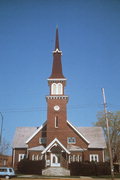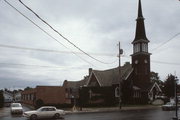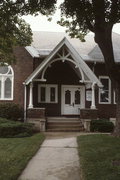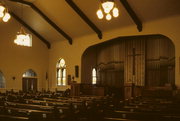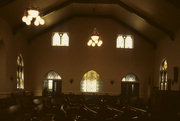| Additional Information: | A 'site file' exists for this property. It contains additional information such as correspondence, newspaper clippings, or historical information. It is a public record and may be viewed in person at the Wisconsin Historical Society, State Historic Preservation Office.
Originally a frame church building, this structure was veneered with red brick in 1922. The entrance is located in the base of the tower, which is capped by a slender spire which rises from flared eaves. Gable roofed transepts intersect the nave of the church and contain stained glass windows.
Although not the first to hold prayer meetings, the First Evangelical Congregational Church of Prairieville was the first congregation to organize in Waukesha County. The first meeting was held in the log cabin of Robert Love, which was located south of Bethesda Spring, on January 20, 1838. Meetings were held in various homes until May 1839 when they were held in the settlement's log schoolhouse. Later that year, the congregation built the first church in the County at what is now the southeast corner of Maple and Wisconsin Avenues facing Cutler Park. This was also the first Congregational Church in the State of Wisconsin. In 1859, the original church expanded and, seven years later, sold as the congregation built a larger strcuture at the present 709 N. East Avenue. This frame building, completed the summer of 1867, is the basis for the existing building. It was expanded in 1899 when north, south and east wings were added as well as the stained glass windows, In 1922, the frame building was faced with brick. An interior remodeling took place in 1928. The Congregational Church was an early influence on the social fabric of the community. It took an early anti-slavery stand and members of the parish, most notably Lyman Goodnow, were involved in the Caroline Quarrels runaway slave episode in 1842. In 1846, the parish adopted a strong anti-slavery resolution taking the leadership in the anti-slavery movement in Waukesha County. In that same year, the Reverence Ichabod Codding, anoted abolitionist lectureer and later editor of the American Freeman, abolitionist newspaper, became pastor and remained for a year.
March 2005-The First Congregational Church was listed on the National Register of Historic Places on 30 January 1992. Therefore, no further research is necessary. |
|---|
| Bibliographic References: | (A) Centennial Directory and Historical Souvenier of the First Congregational Church, 1938.
(B) Butterfield, The History of Waukesha County, Wisconsin, 1880, p. 642.
(C) Penn Loerke, Jean. "The Spires of Waukesha: Ten Churches Plus One" Waukesha County Museum, May, 1975. |
|---|

